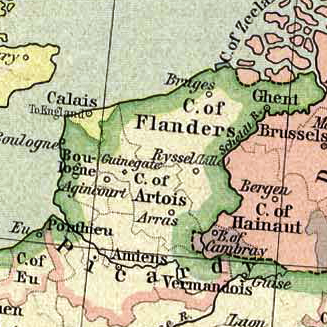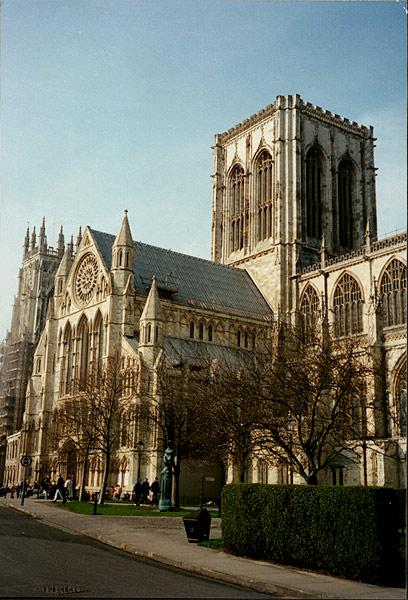|
Richard Andrew
Richard Andrew (died 1477) was a Canon of Windsor from 1450 to 1455,''Fasti Wyndesorienses'', May 1950. S.L. Ollard. Published by the Dean and Canons of St George's Chapel, Windsor Castle Archdeacon of Sarum from 1441 to 1444 and Dean of York from 1452 - 1477. Career He was appointed: *First warden of All Souls College, Oxford 1437 - 1442 * Archdeacon of Sarum 1441 - 1444 *Prebendary of Farringdon in Salisbury 1447 *Prebendary of Stratton in Salisbury 1449 *Prebendary of North Grantham in Salisbury 1454 *Prebendary of Warthill in York 1445 *Prebendary of Newbald in York 1449 * Dean of York 1452 - 1477 *Prebendary of Oxton in Southwell 1461 - 1476 *King's secretary *Rector of Hayes, Kent He was appointed to the ninth stall in St George's Chapel, Windsor Castle St George's Chapel, formally titled The King's Free Chapel of the College of St George, Windsor Castle, at Windsor Castle in England is a castle chapel built in the late-medieval Perpendicular Gothic style. It is a ... [...More Info...] [...Related Items...] OR: [Wikipedia] [Google] [Baidu] |
Dean And Canons Of Windsor
The Dean and Canons of Windsor are the ecclesiastical body of St George's Chapel, Windsor Castle, St George's Chapel at Windsor Castle. Foundation The college of canons was established in 1348 by letters patent of Edward III of England, King Edward III. It was formally constituted on the feast of Andrew the Apostle, St Andrew the Apostle, 30 November 1352, when the statutes drawn up by William Edington, bishop of Winchester, as papal delegate, were solemnly delivered to William Mugge, the warden of the college. Accepting that the process of foundation took several years to complete, the college takes the year 1348 as its formal date of foundation. Costume Three ancient monumental brasses survive depicting canons of Windsor, wearing the mantle of the Order of the Garter, purple in colour, with a circular badge on the left shoulder, displaying: ''Argent, a cross gules'' (a Saint George's Cross): #c. 1370. Roger Parkers, North Stoke, Oxfordshire (half effigy with inscription; h ... [...More Info...] [...Related Items...] OR: [Wikipedia] [Google] [Baidu] |
Archdeacon Of Sarum
The Archdeacon of Sarum is a senior ecclesiastical officer within the Diocese of Salisbury, England. He or she is responsible for the disciplinary supervision of the clergy within the five Rural Dean, area deaneries of the Sarum archdeaconry, which cover the geographical areas of Alderbury, Chalke (west of Salisbury), Salisbury, Heytesbury and Stonehenge (north of Salisbury). The post is currently held by Venerable, the Ven Alan Jeans. History The first recorded archdeacons in Salisbury diocese occur soon after the Norman Conquest (as they do across England) and there were apparently four archdeacons from the outset. However, no territorial titles are recorded until after . The archdeacons at that time were (in order of seniority) the Archdeacons of Dorset, Berkshire, Sarum and Wiltshire. The position was redefined in 1843, having been previously generally known as the Archdeaconry of Salisbury; the role is now generally called Archdeacon of Sarum, but both names have been used c ... [...More Info...] [...Related Items...] OR: [Wikipedia] [Google] [Baidu] |
Dean Of York
The Dean of York is the member of the clergy who is responsible for the running of the York Minster cathedral. As well as being the head of the cathedral church of the diocese and the metropolitical church of the province, the Dean of York holds preeminence as the Province of York vicar. Since 1939, the deans have resided at York Deanery. List of deans The following is a list of the deans from 11th century to the present day: High Medieval *1093– Hugh *–1143 William of St. Barbara *–1157 Robert of Ghent *1158–1186 Robert Butevilain *1186–1189 Hubert Walter *1189–1194 Henry Marshal *1194–1214 Simon of Apulia *1214–? William Testard *– Hamo *1220–1233 Roger de Insula *1233–1238 Geoffrey de Norwich *1239–1243 Fulk Basset *1244–1249 Walter of Kirkham *–1256 Sewal de Bovil *1257–1258 Godfrey Ludham *1258–1260 Roger de Holderness (alias Skeffling) *–1279 William Langton *1279–1290 Robert de Scarborough *1290–1297 Henry of Newark ... [...More Info...] [...Related Items...] OR: [Wikipedia] [Google] [Baidu] |
All Souls College, Oxford
All Souls College (official name: The College of All Souls of the Faithful Departed, of Oxford) is a constituent college of the University of Oxford in England. Unique to All Souls, all of its members automatically become fellows (i.e., full members of the college's governing body). It has no student members, but each year, recent graduates are eligible to apply for a small number of examination fellowships through a competitive examination (once described as "the hardest exam in the world") and, for those shortlisted after the examinations, an interview.Is the All Souls College entrance exam easy now? , ''The Guardian'', 17 May 2010. The college entrance is on the north side of [...More Info...] [...Related Items...] OR: [Wikipedia] [Google] [Baidu] |
St George's Chapel, Windsor Castle
St George's Chapel, formally titled The King's Free Chapel of the College of St George, Windsor Castle, at Windsor Castle in England is a castle chapel built in the late-medieval Perpendicular Gothic style. It is a Royal peculiar, Royal Peculiar (a church under the direct jurisdiction of the monarch), and the Chapel of the Order of the Garter. St George's Chapel was founded in the 14th century by Edward III of England, King Edward III and extensively enlarged in the late 15th century. It is located in the Bailey (castle), Lower Ward of the castle. The castle has belonged to the monarchy for almost 1,000 years. The chapel has been the scene of many royal services, weddings and burials – in the 19th century, St George's Chapel and the nearby Frogmore, Frogmore Gardens superseded Westminster Abbey as the chosen burial place for the British royal family. The running of the chapel is the responsibility of the dean and Canons of Windsor who make up the Collegiate church, College of ... [...More Info...] [...Related Items...] OR: [Wikipedia] [Google] [Baidu] |
1477 Deaths
Year 1477 ( MCDLXXVII) was a common year starting on Wednesday of the Julian calendar. Events January–December * January 5 – Battle of Nancy: Charles the Bold of Burgundy is again defeated, and this time is killed; this marks the end of the Burgundian Wars. * February? – Volcano Bardarbunga erupts in Iceland, with a VEI of 6. * February 11 – Mary of Burgundy, the daughter of Charles the Bold, is forced by her disgruntled subjects to sign the '' Great Privilege'', by which the Flemish cities recover all the local and communal rights which have been abolished by the decrees of the dukes of Burgundy, in their efforts to create a centralized state in the Low Countries. * February 27 – Uppsala University is founded, becoming the first university in Sweden and all of Scandinavia. * August 19 – Mary of Burgundy marries Maximilian I, Holy Roman Emperor, in Ghent, bringing her Flemish and Burgundian lands into the Holy Roman Empire, and detaching ... [...More Info...] [...Related Items...] OR: [Wikipedia] [Google] [Baidu] |
Canons Of Windsor
The Dean and Canons of Windsor are the ecclesiastical body of St George's Chapel at Windsor Castle. Foundation The college of canons was established in 1348 by letters patent of King Edward III. It was formally constituted on the feast of St Andrew the Apostle, 30 November 1352, when the statutes drawn up by William Edington, bishop of Winchester, as papal delegate, were solemnly delivered to William Mugge, the warden of the college. Accepting that the process of foundation took several years to complete, the college takes the year 1348 as its formal date of foundation. Costume Three ancient monumental brasses survive depicting canons of Windsor, wearing the mantle of the Order of the Garter, purple in colour, with a circular badge on the left shoulder, displaying: ''Argent, a cross gules'' (a Saint George's Cross): #c. 1370. Roger Parkers, North Stoke, Oxfordshire (half effigy with inscription; head lost). #1540. Roger Lupton, LL.D., Provost of Eton College and Canon of ... [...More Info...] [...Related Items...] OR: [Wikipedia] [Google] [Baidu] |
Deans Of York
The Dean of York is the member of the clergy who is responsible for the running of the York Minster cathedral. As well as being the head of the cathedral church of the diocese and the metropolitical church of the province, the Dean of York holds preeminence as the Province of York vicar. Since 1939, the deans have resided at York Deanery. List of deans The following is a list of the deans from 11th century to the present day: High Medieval *1093– Hugh *–1143 William of St. Barbara *–1157 Robert of Ghent *1158–1186 Robert Butevilain *1186–1189 Hubert Walter *1189–1194 Henry Marshal *1194–1214 Simon of Apulia *1214–? William Testard *– Hamo *1220–1233 Roger de Insula *1233–1238 Geoffrey de Norwich *1239–1243 Fulk Basset *1244–1249 Walter of Kirkham *–1256 Sewal de Bovil *1257–1258 Godfrey Ludham *1258–1260 Roger de Holderness (alias Skeffling) *–1279 William Langton *1279–1290 Robert de Scarborough *1290–1297 Henry of Newark ... [...More Info...] [...Related Items...] OR: [Wikipedia] [Google] [Baidu] |
Archdeacons Of Sarum
An archdeacon is a senior clergy position in the Church of the East, Chaldean Catholic Church, Syriac Orthodox Church, Anglican Communion, St Thomas Christians, Eastern Orthodox churches and some other Christian denominations, above that of most clergy and below a bishop. In the High Middle Ages it was the most senior diocesan position below a bishop in the Catholic Church. An archdeacon is often responsible for administration within an archdeaconry, which is the principal subdivision of the diocese. The ''Oxford Dictionary of the Christian Church'' has defined an archdeacon as "A cleric having a defined administrative authority delegated to him by the bishop in the whole or part of the diocese.". The office has often been described metaphorically as ''oculus episcopi'', the "bishop's eye". Catholic Church In the Latin Catholic Church, the post of archdeacon, originally an ordained deacon (rather than a priest), was once one of great importance as a senior official of a diocese ... [...More Info...] [...Related Items...] OR: [Wikipedia] [Google] [Baidu] |





